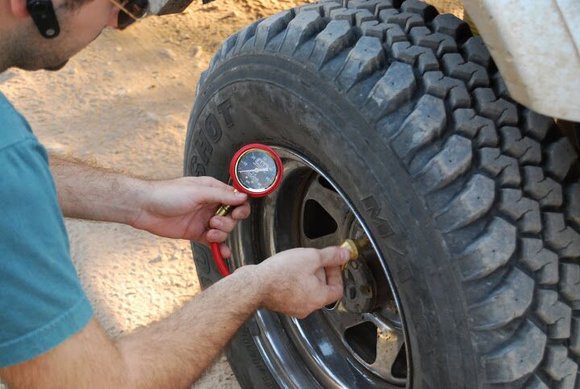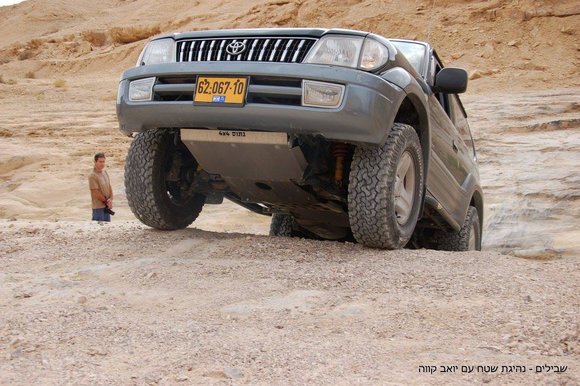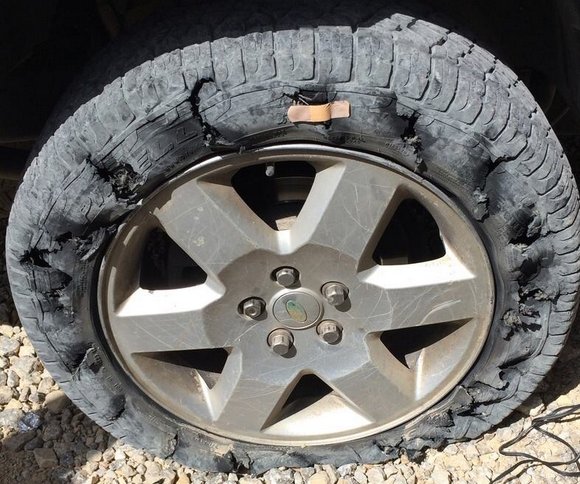It is commonly thought that reducing tires air pressure is only for driving over sand, but that is a mistake!
If your car is equipped with off road tires then the air pressure should be reduced every single time you go off road.
 Reducing air pressure in MT tires
Reducing air pressure in MT tires
The world of off road tires can be divided into three main categories:
HT - Highway Terrain: 70% to 80% road suitability and 30% to 30% off road (of course there are also 100% road suitable tires)
AT - All Terrain: 50% road, 50% off road (often referred to as "half-half")
MT - Mud Terrain: 70% to 80% off road suitability and 30% to 30% road ("mudim")
The more a tire is road-suitable the less suitable it is for off road driving and vice versa.
while driving off road we want our tires to have a good grip and not get damaged. We also want the tires to contribute to the comfort of the ride. Reducing the air pressure could be helpful for various things.
Reducing air pressure in HT tires (road tires)
HT tires are soft and rather volnurable. These type of tires are originaly set on many models such as Suzuki Jamini, Mitzubishi Pajero, Land Rover Discovery and sometimes also on Toyota Landcruiser. In these tires it is advisable not to reduce the air pressure to less than 30 PSI, because of their delicate sides that are prone to be sensitive to cuts and bruises. Often it is even advisable to add some pressure before going off road.
 AT tires "half-half"
AT tires "half-half"
Reducing the pressure in AT tires
The range of AT tires is pretty wide and saying that they are all 50% road and 50% off road would be a wrong generalization. Some AT tires are more suitable to the off road whereas some are less. Overall, for those you go off-roading more than 6 times a year they would be a good choise and a sensible compromise between the road and the terrain. Originally AT tires and found one Jeep wrangler and sometimes on Toyota Landcruiser. in AT tires that have a stronger more stable side than HT, pressure should be reduced to the range of 25 to 27 PSI.
 A Land Rover Discovery shredded AT tire
A Land Rover Discovery shredded AT tire
For AT tires, the faster we drive and the more the trail is filled with sharp stones the more we will chose to set the pressure to the higher end. On the other hand, the slower we go the lower the air pressure should be. While passing rocky trails where we have to go real slow it is advisable to reduce the pressure even more. The gain we will receive in improved grip will be well worth it. For example, say your vehicle has AT tires, you want to climb a steep rocky slope - such as Ma'ale Marzeva in the Arava - and you want to do it most efficiently and safely, you should deflate the tires as low as 15 PSI and once you conquer the top increase the pressure back to 22-25 PSI.
Setting the air pressure for MT tires
This type of tires are tough and durable. In fact, if we do not reduce the pressure significantly we will experience discomfort. It is advisable to reduce the tire air pressure to the range of 15-20 PSI. Here as well, the faster we plan to go and the more the road is strewn with sharp stones the higher we go on the scale. The opposite is true as well. The slower we go while the need for good grip rises the more we reduce the pressure. For example, in stone fall prone slopes, such as Ma'ale Mahmal in the Negev, the air pressure should be reduced to as low as 10-15 PSI.
Summery
Deflating the tires to lower pressure improves the grip the car has on the trail, it makes the ride more comfortable and reduces the risk of punctures and cuts. Apart from special cases (road tires or low cut tires) it is recommended not to be lazy - stop, go out and reduce the tire air pressure before you go off-road.
